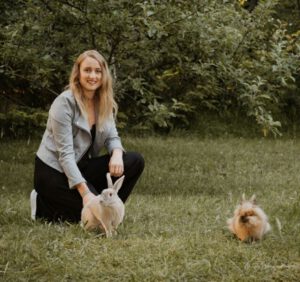Preliminary Considerations for a Successful Rabbit Bonding
The better the meeting of the rabbits is planned and the more informed the owner is, the smoother and less stressful the bonding process will be.
What Factors Influence Rabbit Bonding?
The Right Location: Where Should the Rabbits Meet?

Bonding is necessary because rabbits are territorial animals and will both defend their space and establish a new hierarchy when a new rabbit is introduced. By letting the rabbits meet in a space that is unfamiliar to both of them—outside of their existing territory—one major point of conflict is removed: territory. That means the bonding process will focus solely on establishing hierarchy, which often leads to a calmer interaction.
This is especially helpful for people who are new to bonding rabbits. A completely neutral area—where neither rabbit has been before—is ideal. In unfamiliar surroundings, rabbits are often more reserved due to slight insecurity, which can reduce initial aggression.
It can also be helpful to bond indoor rabbits in the garden and outdoor rabbits inside the house. The more unfamiliar the environment, the better! For free-roaming house rabbits, good bonding locations might include the bathroom (if they don’t normally access it), the balcony, a storage room, the garden, or even a garage. If possible, you could also ask a friend or neighbor to host the bonding session at their place.
Important: Never place one rabbit directly into the cage or territory of another!
In some cases—like rabbits with very large living areas (e.g., free-roaming outdoors) and low territorial behavior—a bonding might work even without neutral space. However, with highly territorial rabbits living in smaller spaces, this can end badly.
In general, female rabbits tend to defend their territory more aggressively than males, although there are exceptions.

Contents
- The Right Amount of Space: How Big Should the Bonding Area Be?
- The Right Setup: How Should the Bonding Area Be Arranged?
- How Should the Rabbits Be Prepared?
- The Bonding Process: Introducing Rabbits to Each OtherPossible Methods
- Is Bonding Necessary?
- Method 1: Bonding Outside of Their Territory
- Method 2a: Two Territories with Neutral Meetings in the Middle
- Method 2b: Neutral Meetings with Interruptions
- Method 3: Living Side by Side in a Very Large Area
- Method 4: Cage-to-Cage (Cage Next to Cage)
- Method 5: Stress Bonding
- Method 6: Letting Rabbits Wake Up from Anesthesia Together
- Incompatible Animals?
The Right Amount of Space: How Big Should the Bonding Area Be?
The larger the space, the gentler the bonding process tends to be—but it usually takes more time. The less space the rabbits have, the faster the bonding may progress, but it can also be much more intense and stressful. It’s helpful to adjust the size of the bonding area depending on how things are going.

If the rabbits are just avoiding each other, the space can be reduced. If things are getting too aggressive and one rabbit is suffering, the space should be increased to give them more room to retreat and calm down. In some cases, however, reducing the space can actually help speed up the bonding process and bring it to a conclusion more quickly.
When rabbits have too much space, they may never properly bond. Instead, they might act on their dislike for each other more strongly. Rabbits that don’t get along well may learn to tolerate each other in a smaller space, while in a large area (like an entire garden), they might avoid each other or engage in more serious fights.
So while bonding may seem more „successful“ in a smaller area, it’s sometimes more of a forced coexistence than a true, harmonious relationship.
As a general guideline, starting with about 3 square meters (32 square feet) per rabbit is a good rule of thumb.
The Right Setup: How Should the Bonding Area Be Arranged?
Ideally, the bonding area should not contain any familiar objects from the rabbits’ previous living spaces. Instead, use completely neutral items. Cardboard boxes with both an entrance and an exit are great options—they prevent dead ends, which should be avoided during bonding sessions.
Other good items include tunnels, tubes, willow bridges, and elevated platforms. The rabbits should have enough hiding places and options for retreat. However, depending on how the bonding progresses, it might become necessary to remove some of these hideouts—especially if the rabbits are avoiding each other too much or the process is dragging on for too long.
The floor should be non-slip. This can be achieved with non-slip PVC flooring or a large blanket secured at the edges.
It’s also helpful to scatter a variety of food around the area. This encourages natural foraging behavior and can help reduce tension.

How Should the Rabbits Be Prepared?
It’s often recommended to let rabbits sniff each other through a barrier before the actual bonding. However, this approach can often lead to failed bonding attempts. Instead, rabbits that are going to be bonded should have no visual contact with each other for about two weeks beforehand. This allows them to calm down and helps create a “fresh start” when they finally meet face to face.
All rabbits involved in the bonding process should be healthy and in good condition to ensure the best chances of success.
The Bonding Process: Introducing Rabbits to Each Other
Possible Methods
Rabbits are social animals, so it is important to always keep them in small groups—never a single rabbit. They thrive in companionship, and living alone can cause stress, boredom, and behavioral problems.
Is Bonding Necessary?
The easiest scenario is when a pair of rabbits—a female rabbit and a male partner (a neutered buck, neutered before sexual maturity)—are raised together, or when an existing, well-bonded group of rabbits is adopted. However, if you want to introduce unfamiliar rabbits to each other, bonding is required. Never simply place the new rabbit with the existing one; this approach often leads to failure.
Method 1: Bonding Outside of Their Territory
This method is particularly suitable for rabbit beginners or people who may feel anxious about the bonding process. It also offers the highest success rate compared to other bonding methods.
Before attempting the bonding, the rabbits should be kept apart for at least two weeks in separate enclosures, where they cannot see or smell each other. This helps ensure that the process of establishing their hierarchy will be less stressful and dangerous. The rabbits should be introduced in a neutral area, one that neither of them knows, to prevent territorial aggression. If one rabbit perceives the other as an intruder, it will escalate the fighting.


For outdoor rabbits, it’s best to bond them indoors, and for indoor rabbits, bonding them in the garden works well. Both rabbits should be placed in the new area at the same time and should not have any prior contact, such as sniffing each other through a barrier.
It’s important to scatter food (like hay and fresh vegetables) around the area, and also provide new hiding spots. Avoid using hiding places that the rabbits are already familiar with! When setting up the hides, ensure that no rabbit can corner the other, such as by using houses with only one entrance.
The rabbits will now go through the process of establishing their hierarchy by fighting, mounting, and pulling out fur. Chasing and bickering is completely normal and necessary for them to determine their place in the group. Only after this process can they live together harmoniously.


You should remain nearby or check on them frequently to intervene if necessary—such as if they start seriously biting each other (throwing a blanket over them or between them to separate them), if one rabbit is suffering excessively (refusing to eat, sitting with its head against the cage or wall, etc.), or if serious injuries occur that require a vet’s attention.
It may take several weeks for them to settle down and become comfortable with each other. Once they are eating together and sitting close to each other, they can be moved back into one of their original enclosures. The previous living area should be thoroughly cleaned with vinegar water beforehand. For the transition, only neutral items and furniture should be used, and the layout of the enclosure should be adjusted.
There might still be some minor scuffles when they move back into the original territory, but these will usually resolve quickly.
Method 2a: Two Territories with Neutral Meetings in the Middle
This method is only possible if each rabbit group (or, in the case of bonding two rabbits, each rabbit) has its own territory (such as a room in the house or a section of the garden) where it has settled in and considers it its territory. Additionally, there must be a neutral area between these two territories (such as a hallway, another room, or a separate garden section).
The rabbits should not have any visual or olfactory contact for at least two weeks before the bonding process begins. On the day of the bonding, both territories are opened up to the neutral area, and items like cardboard boxes (without dead ends) are set up to encourage the rabbits to explore the space out of curiosity.


The rabbits should always have the option to return to their own territory, but the owner must ensure that the rabbits do not enter the other rabbit’s territory. These neutral meetings should take place multiple times a day under the supervision of the owner.
During these meetings in the neutral area, the rabbits may fight and chase each other as part of the process of establishing their hierarchy—do not intervene. Once they start eating together and seem to be getting along, there are two options:
- You can allow them to enter the other rabbit’s territory and observe how they interact until they are comfortable and accept each other.
- Alternatively, you can leave them in the neutral area for two days and two nights. During this time, their old territories should be thoroughly cleaned and filled with neutral items. Afterward, they can return to their original spaces.
Method 2b: Neutral Meetings with Interruptions
It is also possible to place the rabbits back in their original enclosures at night (never leave one rabbit in the neutral area!), and move them into the neutral area during the day, or whenever the owner is available (ideally for as long as possible each day). When separated, the rabbits should not be able to see each other, and they should not have any interaction (such as sniffing each other) for two weeks before the bonding process.
The disadvantages of this method include the fact that after each separation, the rabbits will likely „fight“ a bit more intensely, and the bonding process takes longer compared to a continuous approach. Additionally, this form of bonding tends to fail more often than continuous bonding without interruptions. It is generally recommended for more experienced rabbit owners.
The main advantage is that you don’t need a predator-proof neutral area; you can simply move the rabbits into a neutral space during the day.

Method 3: Living Side by Side in a Very Large Area
(This method is only possible with free-range garden or free-roaming indoor rabbits.)
If the rabbits live freely in an area of at least 150m², you can bond them directly in their own territory. However, special attention should be given to the new rabbit (territorial intruder) to ensure it does not suffer too much. The rabbits should have plenty of space to avoid each other when necessary.
This method is recommended only for experienced rabbit owners. Often, the rabbits will get along in the large territory after a while, but they might still have issues in the night enclosure, where territorial boundaries are more strictly enforced.
In this case, it is helpful to set up a small enclosure with tight mesh (so that no rabbit can chew through it) within the larger night enclosure, where the new rabbit can stay. After a few weeks, the established rabbits will likely become accustomed to the new rabbit being in the night enclosure and accept it more easily.
It’s best to place the small enclosure in a position where it doesn’t dominate the night area, preventing the new rabbit’s space from being seen as its exclusive territory.

Method 4: Cage-to-Cage (Cage Next to Cage)
It is often recommended to place two cages or enclosures next to each other. This method can work, but only if the rabbits are very shy and do not accumulate much aggression. If the rabbits are too territorial, however, keeping them in adjacent cages can lead to severe fighting once they are eventually allowed to meet. The aggression they’ve built up by being near each other will be released all at once, which can result in serious injuries.
This method is recommended for rabbits with disabilities that cannot handle the stress of dominance struggles. It can also help if you regularly swap the rabbits’ enclosures and items so they can get used to each other’s scent. For extreme cases, this method can sometimes be a last resort, as it prevents injury (for example, with rabbits that are prone to aggressive biting). In such cases, very careful patience is required, and you should plan for a long bonding period (around 6 months) before you consider it a success.
Another variation of this method is possible with plenty of space (such as a garden free-range setup). You can place one enclosure in the free-range area and gradually move it daily until the rabbits get used to the idea of sharing the same territory. With a large enough area, the rabbits often release their built-up frustration by digging or running around, which can make this method more effective.

Method 5: Stress Bonding
(Bonding during a car ride in a transport box or on a washing machine during the spin cycle)
The principle behind this method is based on the idea that social animals tend to bond when they have a common enemy (for example, rabbits wouldn’t fight for territory if they were being chased by a fox, or people often come together in difficult times). Therefore, rabbits may cuddle together when they are terrified or in a state of panic.
I have heard of many variations of this method, including people putting their rabbits in a transport box and driving them for half an hour on gravel roads, or the suggestion of placing the rabbits on the spin cycle of a washing machine. I strongly discourage such methods, as they put the rabbits under extreme stress and can lead to serious injuries if the rabbits start fighting in the confined space.
However, elements of this method can be used safely. For example, you can transport two rabbits separately in a transport box in the car to unsettle them slightly and then bond them outside of their territory. This usually leads to a more relaxed bonding process. Additionally, our (rabbit-friendly) dog often intervenes during bonding sessions when the rabbits start to fight and helps settle the conflict. This causes the rabbits to be slightly intimidated, making the bonding process less aggressive.
Method 6: Letting Rabbits Wake Up from Anesthesia Together
A study shows that waking up from anesthesia together helps reduce aggression. This method can be used when, for example, two male rabbits are neutered at the same time, or as a „last resort“ for very difficult rabbits by lightly sedating them (always consult with the veterinarian!) and letting them wake up together.
I often receive unneutered male rabbits that have severely bitten each other during sexual maturity. By allowing them to wake up together after neutering and then keeping them in a neutral area, I have been able to turn them into a perfect pair every time. In these cases, the normal neutral bonding methods have usually been less successful. Of course, the rabbits should still live outside their territory until their relationship has solidified (there may be fights, but do not intervene!). Later, they can move back into their territory.
„A. Cherkin and R. O. Meinecke from the University of Los Angeles sedated a group of particularly aggressive rabbits using the anesthetic sodium pentobarbital. Even fourteen weeks after the sedation, the rabbits lived peacefully together in their cage. They were then isolated for two weeks. When the researchers later placed the rabbits back in a cage together, the peace was gone: Within two minutes, fierce fights broke out. The isolation, Cherkin and Meinecke concluded, had recharged the rabbits‘ aggression.“
„This was confirmed in a second series of experiments with twenty-six rabbits. The rabbits that woke up from anesthesia together with their companions showed little aggression. On the other hand, rabbits that woke up in isolation were particularly aggressive. When these temporarily pacified rabbits were separated again four weeks after anesthesia, they too regained their aggression, which was evidently caused by the isolation.“
Incompatible Animals?
Just like us humans, rabbits form close friendships with other rabbits. However, there are always animals, characters, or combinations that they „just can’t stand.“ This is why not every rabbit will get along with just any other. If, despite a properly conducted bonding process in a neutral area, injuries occur or one rabbit is suffering greatly because of the other, it is pointless to force them to stay together. While it is possible to get rabbits used to each other even if they don’t like each other, this won’t result in a true friendship, and problems may continue to arise later on. They will merely learn to coexist. In large groups, rabbits choose whom they like best. In smaller groups, as an owner, you should pay attention to their behavior during the bonding process and, if necessary, return the new rabbit (after confirming if this is possible) and find a more suitable companion. The fights necessary to establish a hierarchy are part of normal rabbit behavior and are not related to „dislike“ or incompatibility. We have had very good experiences with pairs (neutered male + female); these always worked out for us, even though we have bonded hundreds of rabbits and many of these animals were considered „incompatible.“




















